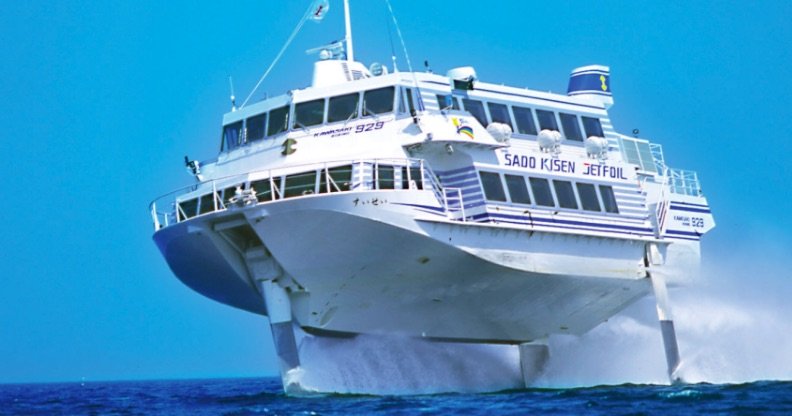Today, I bring you yet another special vehicle apart from the other common ones. Well, we are talking about Hydrofoils. A very simple and elegant solution to the problems current marine vessels are facing. So let’s not waste time & know more about them.
Why Hydrofoils?
You might wonder why do we need them in the first place, right? Let me answer that for you.
As you already know that whenever an object moves through a fluid, it experiences a drag force in opposite direction resisting the motion. So when a ship or any marine vessel moves, it experiences a lot of drag force. Easy to walk on the ground but ever tried walking in water? Exhausting, eh? That’s because water is 50x thicker/viscous than air. Along with that, rough waters and turbulences also reduce the efficiency of ships.
So wouldn’t it be amazing if we could just reduce the drag and increase the efficiency leaving the turbulences hamstrung? Well, that’s what hydrofoils do exactly!
First hydrofoils
The first evidence of a hydrofoil on a vessel appears on a British patent granted in 1869 to Emmanuel Denis Farcot. On his ideas, later in 1898, Enrico Forlanini started working and developing their designs. Further more, in the early 1900s Alexander Graham Bell(Yes.. the same guy who invented the telephone) with his chief engineer, Casey Baldwin started experimenting & testing models based on designs of Forlanini.
Upon his request, the US Navy granted him two 350hp engines for his hydrofoil watercraft HD-4. In September 1919, the HD-4 set a world marine speed record of 114 km/h(71 mph), which stood for 2 decades!
Meaning of hydrofoil
Probably everyone has heard and known about Airfoils, right? A foil is an object which produces lift at a certain angle of attack when moved through a medium. Well, if the medium is air, its called an Airfoil OR Aerofoil and when the medium is water, it’s called a hydrofoil 🤷🏽♂️
Working of Hydrofoils
The shape of the airfoil is such that when moved through a medium, the air flows faster above the surface than underneath it creating a low-pressure zone on top. The pressure difference thus generates lift. The hydrofoil works in a similar fashion.
When the watercraft gains speed, the hydrofoil generates lift elevating most of its hull(at times the entire hull) out of water.
Since most of the watercraft is now in the air, the hull doesn’t generate drag along the way. Well, to be precise, it does produce but by the air which is significantly lower than what the water would’ve produced.
Type of hydrofoils –

Earlier hydrofoils used V-shaped foils. A part of them rises above the water and hence they’re also called surface-piercing foils. The biggest advantage of this type is that they are self-stabilising when it comes to rolling movement.
Another configuration that is generally preferred currently is the T-type. The hydrofoils are just connected perpendicularly to the hull & completely submerged in water.
Since the foils are completely submerged, turbulences and waves don’t rock(pitch) the boat and one could enjoy a smooth ride! However, when it comes to and rolling movement, T-type foils are not self stabilising. Hence, a mechatronic control system changes the angle of attacks of each foil accordingly to maintain the smoothness.
Learn more about rolling-pitching-yawing movements & auto-pilot systems here!
Advantages
- Watercraft with hydrofoils produce much less drag than the ones without them. As a result, they are much more fuel-efficient.
- A reduction in drag also leads to higher cruising speed. Thus reducing travel times.
Disadvantages
- Hydrofoils cannot be used on big ships or marine vessels because they no longer remain efficient considering the maintenance cost.
- The sharp edges of foils can fatally injure fishes and other marine animals.
- Hydrofoils are thin and are sensitive to impacts. A severe impact can break off the foil which can further lead to serious maneuvering problems or worse – accidents.
Current operations
1. A very interesting application of hydrofoils could be seen in surfing where some surfers surf above the water. The surfboards are attached with the foils underneath just like T type configuration and the working principle remains the same.

2. Pertaining to military usage, several hydrofoil based crafts like Turya class torpedo boat, Matka and Sarancha class missile boats were introduced in the late 1900s in USSR and are still in service.
The US Navy also implemented a small number of combat hydrofoils such as Pegasus class but all of them were retired.
3. Soviet-built Voshkhods are the most popular hydrofoils being used currently as passenger boats in more than 20 countries.
Another popularly known hydrofoil boat is Boeing 929, which is widely used for passenger service in many parts of Japan, Macau & HongKong.
.

